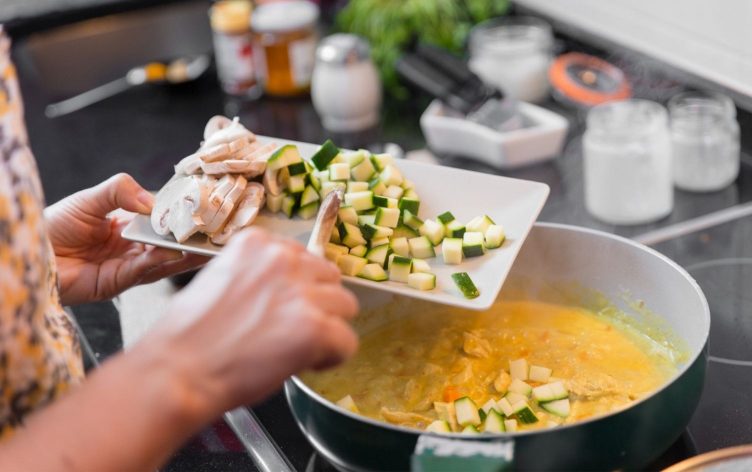
How to Sneak More Veggies Into Your Favorite Family Recipes
If getting your family to eat more veggies is on your list of things to do, you’re going to want to keep reading!
While sneaking in veggies may seem, well, sneaky, my strategy isn’t about “tricking” your family into eating more veggies. What I suggest is consistently increasing your family’s exposure to plant foods and setting an example by modeling the behavior you’re trying to instill. In other words, practice what you preach!
That said, I recognize that sometimes adding more veggies to your menu can be tough, especially when you’re up against discerning palates and competing interests, but it is possible!
Below are a few of my tried-and-true strategies for adding veggies into favorite family recipes.
DOUBLE UP
One way you can sneak in more veggies is to simply double the vegetables already in a dish. This works really well for pasta, casseroles, soups and stews. So, if you’re making a dish that calls for 1 cup of broccoli, add 2. Another way to work this tip is to add more veggies based on the serving size. For example, this Grilled Chicken With Zucchini-Asparagus Saute makes 4 servings. It calls for 3 cups of zucchini and 2 cups of asparagus, so you could increase both amounts of veggies to equal 1 cup of cooked veg per serving (4 cups of each veggie).
Bonus tip: Use colorful food like rainbow carrots or yellow peppers. You’ll get a more colorful meal and younger kids might even have fun eating purple or red carrots as opposed to the usual orange ones.
SHRED IT AND FORGET IT
It’s super easy to add shredded or finely diced vegetables to family favorites. Sub in mushrooms for half the ground beef when making burgers or other meat dishes. Carrots and celery are also easy to hide in meat dishes (if you have picky eaters, try a white carrot, it won’t be as obvious). You can also add “like” veggies to dishes, especially root vegetables. When roasting potatoes, add parsnips or turnips to the sheet pan. If roasting sweet potatoes, mix in some diced butternut squash. If your dish needs a sauce, serve a plant-based gravy like this Mushroom Gravy.
Finely shredded zucchini or steamed carrot and sweet potato are great for muffins, pancakes, breads and waffles. Cooked cauliflower is easy to add to casseroles and mac and cheese. Diced butternut squash works great in chili. And, homemade veggie burgers are the best veg boost!
Bonus tip: Make a cauliflower mash to serve alongside roast chicken or pot roast to add more veggies to those dishes, too.
HOORAY FOR THE PUREE
Try pureeing fruit and veggies together for a boost of flavor and nutrients. Blend blueberries, banana and red cabbage or cauliflower, mango and strawberries to make a fun veggie puree for smoothies, yogurt or oatmeal. Add pumpkin or squash purée to store-bought pancake or waffle mix or add to your own favorite bran muffin recipe. Sweet potato purée also works great in chocolate chip cookies.
Cauliflower is super easy to add to food. Add a simple cauliflower puree to pasta sauce like this Vegan Double Cauliflower Fettuccine Alfredo recipe. For visual eaters, you can skip the roasted cauliflower on top and know they’ll still get it inside the sauce. Steam and purée or finely grate cauliflower to mix with scrambled eggs, oatmeal, smoothies, mashed potatoes or soup!
Blended soups are another great vehicle for increasing veggies. The trick here is to add like-colored veggies to blended soups. No one will notice if you add carrot puree to butternut squash soup or spinach puree to a blended asparagus soup. What veggies?
Bonus tip: Mash avocado into chocolate pudding, smoothies, dips and refried beans for an added boost of fiber and nutrients!
PIZZA FOR THE WIN
Pizza is the perfect vehicle for adding more veggies to the table. Sauteed spinach, finely diced broccoli, mushrooms or roasted red peppers are great compliments to a standard cheese pizza. The trick here is the finely diced part. Discerning palates might not care about smaller veggie pieces, but may turn up their nose at a full-sized broccoli floret!
Pizza crust is also a great way to serve the family more veggies! You can use a cauliflower crust or roasted veggies like in these Sweet Potato Pizzas.
Bonus tip: For a tasty pizza alternative, use the cauliflower crust recipe above to make a quick spinach quiche. If spinach isn’t your jam, use veggies your family likes. You’ll still get some cauliflower in the crust, so you can feel great about getting in an extra serving of veggies and serving your family something they like.
‘RICE’ IS NICE AND ZOODLES ARE NOODLES
You can find veggies masquerading as pasta or rice in the frozen food aisle of the grocery store, or just make your own! A hand-held spiralizer (for zoodles) is a fun job for the kiddos, and a food processor makes the perfect veggie “rice.” Broccoli, sweet potato and cauliflower rice are tasty, easy subs for rice in stir-fry, buddha bowls, tacos, burritos or pasta dishes. Give it a try with this Stir-Fried Cauliflower Rice Bowl.
Bonus tip: Spaghetti squash is another great alternative to pasta. This Cacio e Pepe Spaghetti Squash Boat is easy and delicious, and you won’t miss the pasta at all!
THE BOTTOM LINE
From pasta to soup to pizza, there’s a way to add vegetables to just about anything! While getting your family to eat more plants is a huge win, it can sometimes feel like a challenge. With a little creative thinking (and a commitment to keeping it fun!), you can rework some of your favorites to help boost your family’s health and encourage a more plant-based lifestyle.

































